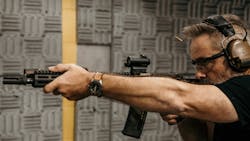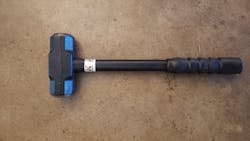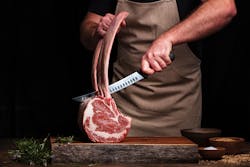4 Steps When Threat Focusing
By Duane Buckner, Aimpoint US Director of Training
Threats are something that we as humans generally find and fixate on in the process of an attack or heightened occurrence. Our intricately designed system allows us to reduce the background “clutter” so we can reach the simplest solution as fast as possible.
An uninterrupted field of view (FOV), paired with a reticle that requires little or no processing—like a simple red dot—is in keeping with that biology. Adding complexity is unavoidable when directing a firearm toward a threat but we can take steps to reduce that tax on our systems and dramatically increase our chances of surviving an attack.
Here are a few tips that we think are important:
1. Keep your tools reliable and simple. This means that you should apply a great deal of effort in choosing them. Consider them from the critical stress perspective. If you have to pause consistently, even for a second to understand the tool…it isn’t a tool—it’s a hindrance. Diligently research your gear and the way they function under abuse. Understand their reliability. Their job is to work when a large part of your recognizable cognitive process is not available to you. There is no back up to this system that we can smoothly transition to.
Tools are important. More important is that they fade into the process. Let’s explore the concept a little further. “Fading into the process” means that a tool does not require the person operating it to actively consider (or drive) the minutiae of its use. A sledgehammer is simple, it allows us to think about the work. A more complex answer is certainly available, but it detracts from the simple goal of driving the stake. The hammer fades into the effort. Everything can’t be a sledgehammer but it’s a handy guide toward choosing simplicity in our tools. If it isn’t adding to the effort without much thought…it’s an impediment…not a tool.
2. Reduce everything to a process. Presenting your pistol or rifle to develop an aiming solution and fire, may seem like a simple thing, and it generally is. Now try doing it while falling off a cliff. The jolt of fear and stress that you imagine in the cliff scenario should serve as a model. Your body is hard wired to change itself under the vagaries of existential stress. The thinking that you are capable of under normal circumstances may be significantly reduced – depending on your context. What is certain is that most human beings are not in a creative mood when their lives are being called into question.
What this means is that we must do the creative thinking before the event. Generally, long before the event. Long enough to develop the skill to a point of “durability.” So, what are durable skills and how do we go about developing them? Put simply, durable skills are those that we can trust to be relatively intact when our systems experience the degradation mentioned above. These are the bedrock of our responses. The draw stroke, the presentation, the aiming solution…these all must work to form a coherent and effective response with a firearm. The only real way to master these things is to reduce them to a repeatable process and expose them to thoughtful repetition. Here is something of a roadmap:
A. Get the highest quality training that you can. This means finding someone that helps you remove inefficiencies and install efficiencies in their place. Make certain that you are being taught…not just measured.
B. Reduce each part of the eventual process to its component parts. Identify the small actions that come together to make an effective effort and be able to visualize them in their entirety.
C. Slowly train to these simplified movements in concert until they become “entrenched.” A good indicator that you have built a durable skill is that your mind wanders slightly off the task at hand, and you maintain an acceptable performance standard. This means that you have spare capacity and that your brain is not being overly taxed by delivering the desired result.
3. Don’t go fast. Speed is the outcome of consistent training. In Step #2 you hopefully removed the inefficiencies involved in your process. This is speed in its infancy. Let’s consider an example: a butcher. If you’ve ever seen a professional butcher use a knife it’s impressive…and a little terrifying at the same time. They wield knives as if they were appendages. Is it reasonable to think that long experience made them this fast? Yes. Imagine showing up as a “butcher trainee” and being told to move the knife as fast as you could. This would result in disaster…and very likely a few less fingers. Speed must be developed. It is biological.You also risk installing the wrong skill when you push yourself too early. You can become very good at doing something very badly. Have you ever seen someone that is truly great at something? They look completely non-plussed in their movements. They are fluid and…fast. This is the goal. Develop speed, you can’t force it.
4. Situational awareness. Be aware of your surroundings and you will likely never put yourself in a dangerous scenario to begin with. This is much harder than we think. We all would like to consider ourselves aware. We would like to think that we know our surroundings inside and out. The truth is much less inspiring without working at it. We simply don’t “see” the way we think we do. In fact, we “see” far less of the world than is available. This is born of necessity and efficiency. There is an enormous amount of information to take in. Our brains build models that allow much of that available information to blend into maps of “expectation.” We might call these: biases. If something is always in the same place, your expectation may not allow you to see its absence.
This is also how we can look directly at something and simply not see it. If we don’t expect it, sometimes our minds just gloss over its presence.Consider the tourist at Yellowstone National Park casually strolling through a herd of Bison unaware of their presence or the peril that they have put themselves in. The reason for this, is that the tourist’s experience has not led them to identify the animals as threats or as danger. Being taught the error of their ways by an angry 2,000 pound, charging bull is both effective (you’ll never forget it) and ineffective (if it catches you…). So how do we combat this tendency to miss things and become more situationally aware? John Boyd (of “OODA loop” fame) argued that we should continuously dismantle the world as we see it and put it back together as it is…not as we expect it to be. This sounds like word play but it isn’t. It really is that simple. Here are some tips: Become curious about where you are. Look at the way things are built. Watch the way people move in crowds. Identify five new things on your commute every day. Come up with your own awareness games. Make them different. You’ll be amazed by what you see. And the more you see…the less you’ll be surprised by. Remember, you are doing this to identify things before they occur. Knowing your surrounding is a far better plan than stumbling through the buffalo herd.
To sum it all up: Work to protect your threat focus. Be aware, train intelligently and we humbly suggest using the finest, most reliable red dot sights in the world. Aimpoint sights. Always ready. Always on. Always with you.



